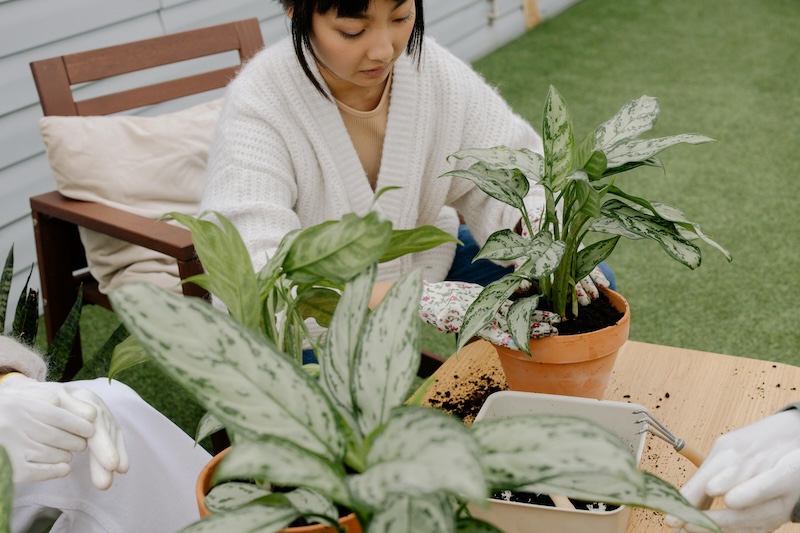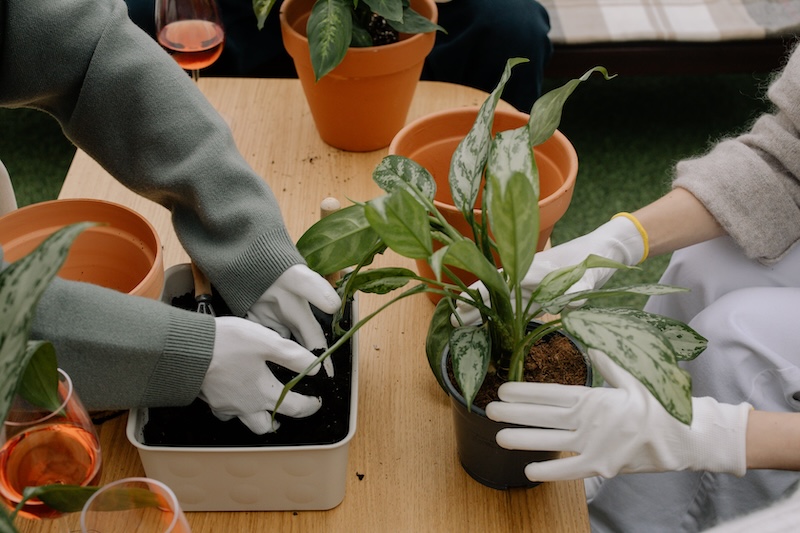Aglaonemas, also called Chinese evergreen, are slow-growing tropical perennials native to Asia. This type of plant has narrow oval leaves in a wide variety of colors and patterns, typically in silver, red, and shades of green. Older plants may reward you with white flowers in the spring.
When you bring your aglaonema home, you may need to move it from its nursery pot to a larger or nicer container. Every few years, you’ll also need to refresh the soil to improve the plant’s overall health. Aglaonema, also referred to as the Poison Dart plant, is toxic to pets, so keep it up high and out of reach.

Potting Aglaonema
If your aglaonema is doing well in its nursery pot, you will not need to repot it. You can disguise the plastic sleeve with a decorative cachepot. Be sure to empty the cachepot after watering.
If the plant’s roots are protruding from the drainage holes, it will need to be moved into a larger container. Choose a pot or container with a drainage hole at the base. Aglaonemas are not picky about their potting media as long as it drains well. You can add a handful of perlite to a peat-based potting mix if you think it’s too heavy or moisture retentive.
After planting, provide your aglaonema with plenty of water, bright light, and humidity. The plant should be in a warm area away from any potential cold drafts.
Repotting Aglaonema
Aglaonema are fairly slow growers so they’ll only need to be repotted every few years, or when you see roots emerging from the drainage hole. Over time, salt from fertilizer and tap water will build up in the soil. Too much salt can harm your plant.
If you notice your plant’s health in decline or the plant is so rootbound that water quickly runs out of the pot, it’s time to refresh the soil. Refresh the plant’s soil every 2-3 years during the spring or early summertime. This timing will make the transition easier for the plant as it will be actively growing. Hot tip: before repotting, first soak the root ball in warm water to help untangle the roots.
Best Soil For Aglaonema
Aglaonemas are not picky about their potting media as long as it drains well. You can add a handful of perlite to a standard peat-based potting soil to lighten the texture and improve drainage. Avoid using soil from the landscape, which is too heavy and dense for most potted plants.

Aglaonema Drainage
The key to proper drainage is using potting soil and containers that drain well and provide an escape for excess water. In addition to using well-draining soil, make sure the plant never sits in water. Always empty the saucer or cachepot after watering. This will prevent most pest, fungal, and disease issues. Keep the soil moist but not wet. Mealybugs, scale, and fungus gnats are known to be attracted to plants in overly wet soil.
 |
Author Chris Link - Published 12-18-2023 |
